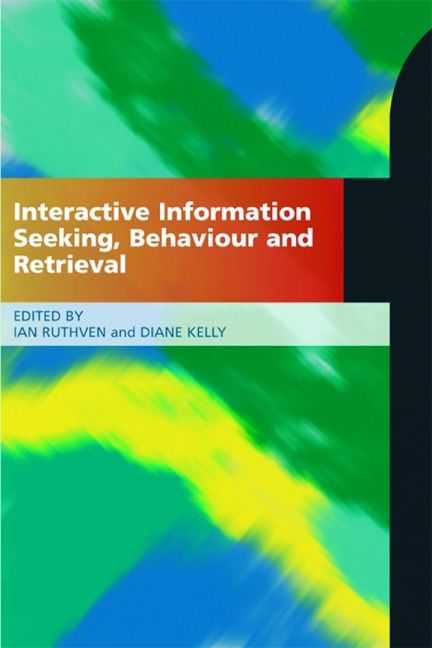Book contents
- Frontmatter
- Dedication
- Contents
- Figures and tables: acknowledgements
- Contributors
- Foreword
- Preface
- 1 Interactive information retrieval: history and background
- 2 Information behavior and seeking
- 3 Task-based information searching and retrieval
- 4 Approaches to investigating information interaction and behaviour
- 5 Information representation
- 6 Access models
- 7 Evaluation
- 8 Interfaces for information retrieval
- 9 Interactive techniques
- 10 Web retrieval, ranking and personalization
- 11 Recommendation, collaboration and social search
- 12 Multimedia: behaviour, interfaces and interaction
- 13 Multimedia: information representation and access
- References
- Index
11 - Recommendation, collaboration and social search
Published online by Cambridge University Press: 08 June 2018
- Frontmatter
- Dedication
- Contents
- Figures and tables: acknowledgements
- Contributors
- Foreword
- Preface
- 1 Interactive information retrieval: history and background
- 2 Information behavior and seeking
- 3 Task-based information searching and retrieval
- 4 Approaches to investigating information interaction and behaviour
- 5 Information representation
- 6 Access models
- 7 Evaluation
- 8 Interfaces for information retrieval
- 9 Interactive techniques
- 10 Web retrieval, ranking and personalization
- 11 Recommendation, collaboration and social search
- 12 Multimedia: behaviour, interfaces and interaction
- 13 Multimedia: information representation and access
- References
- Index
Summary
Introduction
This chapter considers the social component of interactive information retrieval: what is the role of other people in searching and browsing? For simplicity we begin by considering situations without computers. After all, you can interactively retrieve information without a computer; you just have to interact with someone or something else. Such an analysis can then help us think about the new forms of collaborative interactions that extend our conceptions of information search, made possible by the growth of networked ubiquitous computing technology.
Information searching and browsing have often been conceptualized as solitary activities; however, they always have a social component. We may talk about ‘the’ searcher or ‘the’ user of a database or information resource. Our focus may be on individual uses and our research may look at individual users. Our experiments may be designed to observe the behaviors of individual subjects. Our models and theories derived from our empirical analyses may focus substantially or exclusively on an individual's evolving goals, thoughts, beliefs, emotions and actions. Nevertheless there are always social aspects of information seeking and use present, both implicitly and explicitly.
We start by summarizing some of the history of information access with an emphasis on social and collaborative interactions. Then we look at the nature of recommendations, social search and interfaces to support collaboration between information seekers. Following this we consider how the design of interactive information systems is influenced by social elements.
Background
The history of organized information is, necessarily, one of social relationships. The organizers structured documents to ease retrieval, possibly for themselves in the first instance, but then for users who wished to access the collection. Personal libraries, organizational libraries, and then public libraries provided access to information resources hundreds of years before computers arrived. These libraries contained, or indeed embodied, two main social relationships between the librarians and the users. The simplest relationship was a dialogue between the information seeker and the librarian, which has evolved into the reference interview. The other relationship was indirect, via the structure of the collection; where the librarians arranged the items to facilitate retrieval. These arrangements have evolved into classification systems such as the Dewey Decimal Classification. As the literary record grew through books and journals the connections between published works, authors, readers and information seekers have become ever more complex.
- Type
- Chapter
- Information
- Interactive Information Seeking, Behaviour and Retrieval , pp. 205 - 220Publisher: FacetPrint publication year: 2011
- 1
- Cited by

